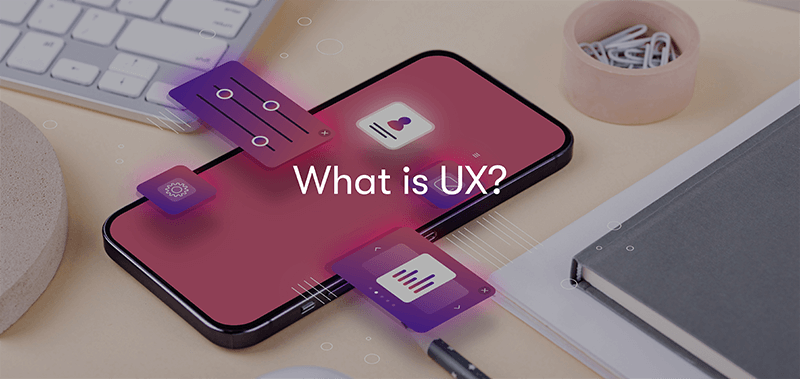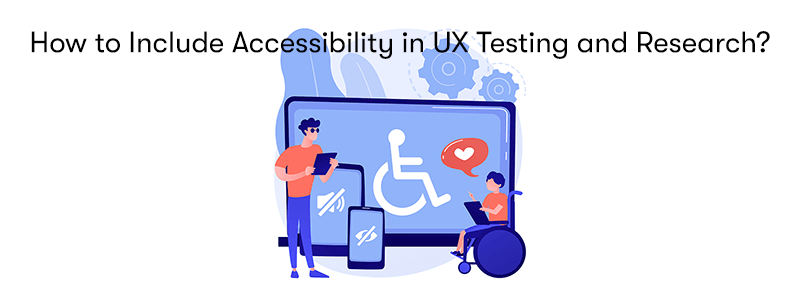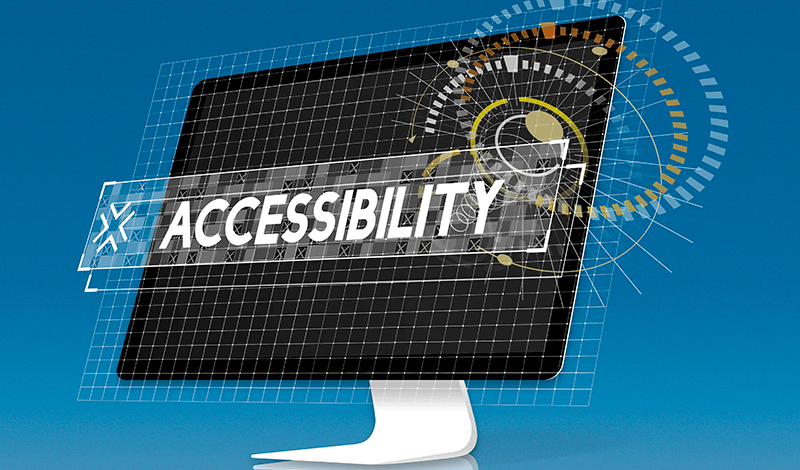What is UX Accessibility?
UX (User Experience) Accessibility refers to the practice of ensuring that digital products, services, and environments are designed and developed in a way that allows individuals with disabilities to access, use, and interact with them effectively and equitably. It focuses on creating an inclusive and barrier-free user experience, regardless of physical or cognitive impairments.
Key aspects of UX Accessibility include:
- Adhering to accessibility standards.
- Implementing accessible design and interaction elements.
- Providing alternative formats for content.
- Conducting usability testing with diverse user groups, including individuals with disabilities.
UX Accessibility aims to make technology and information accessible to everyone, promoting equal opportunities and a more inclusive digital landscape.
What is UX?

UX stands for User Experience, and it refers to a person's overall experience when interacting with a product, system, or service. UX design is the process of designing products and systems with the user's experience in mind, aiming to make them easy to use, efficient, enjoyable, and satisfying.
UX design is crucial in today's digital world, as it directly impacts user satisfaction, retention, and the success of a product or service. Good UX design not only helps users accomplish their goals efficiently but also creates positive perceptions and fosters brand loyalty. It involves an ongoing process of iteration and improvement to adapt to changing user needs and technology advancements.
How is Accessibility Important in UX?

Accessibility significantly contributes to a positive User Experience in several ways:
Inclusivity
Accessibility ensures that a product or service can be used by the broadest possible range of people, including those with disabilities. When everyone can access and use a product or service, it fosters a sense of inclusivity and makes users feel valued.
Improved Usability
Accessible design often leads to better usability for all users. Clear and consistent navigation, well-structured content, and meaningful labels benefit everyone, not just those with disabilities. An accessible design typically results in a more intuitive and user-friendly experience.
Enhanced User Satisfaction
When users can easily accomplish their tasks and find the information they need, they are more likely to have a positive experience and be satisfied with the product or service. Accessibility contributes to reducing frustration and increasing user satisfaction.
Increased Reach
Making a product or service accessible broadens its potential audience. This includes individuals with disabilities and people with situational limitations (e.g., using a mobile device in bright sunlight or a noisy environment). You can reach a more extensive and more diverse user base by addressing diverse needs.
Long-Term Value
Accessibility future-proofs your product. As users age or encounter temporary limitations (e.g., due to illness or injury), they may rely on accessible features they previously didn't need. Ensuring your product remains usable for these users can lead to long-term customer loyalty.
Positive Brand Image
Demonstrating a commitment to accessibility can enhance your brand's reputation and build trust with users. It shows that your organisation values diversity and is dedicated to providing an inclusive experience.
Innovation
Addressing accessibility challenges often drives innovation. Solving accessibility problems can lead to creative solutions that benefit all users and push the boundaries of design and technology.
SEO Benefits
Accessible websites and content often perform better in search engine rankings. Adequately structured content and metadata, which are required for accessibility, can improve discoverability and drive more traffic to your website.
In essence, accessibility is integral to creating a positive and inclusive user experience. It not only benefits users with disabilities but also enhances the overall usability and satisfaction of your product or service for all users. Accessibility should be considered from the beginning of the design process and continuously integrated into developing and maintaining digital products and services.
Why is Accessibility So Important?

Accessibility is paramount for UX because it directly impacts the quality of the user experience for all individuals. By designing products and services with accessibility, we ensure that everyone, including people with disabilities, can access and use digital content and physical spaces effectively. This commitment to inclusivity fosters a sense of equal opportunity and respect for all users, leading to increased satisfaction and engagement.
Accessible designs often result in improved usability, clearer navigation, and better overall user experiences, benefiting everyone, not just those with disabilities. Accessibility is the cornerstone of creating positive, user-centric experiences that reach a broader audience, comply with legal requirements, and uphold ethical principles of equal access and inclusion.
What Are Some Best Practices for UX Accessibility?

UX accessibility best practices are guidelines and strategies ensuring digital products, services, and websites are designed and developed with inclusivity. These best practices help create user experiences that are accessible to all individuals, including those with disabilities. Here are some key UX accessibility best practices:
Adhere to Accessibility Standards
Follow established accessibility standards and guidelines, such as the Web Content Accessibility Guidelines (WCAG), to ensure your design and content meet recognised accessibility criteria.
Semantic HTML
Use semantic HTML elements to structure your content correctly. This includes using headings, lists, and proper form elements. Semantic HTML helps screen readers and other assistive technologies interpret and present content accurately.
Keyboard Accessibility
Ensure that all interactive elements and content can be accessed and operated using a keyboard alone. Test keyboard navigation to ensure a logical and consistent flow.
Provide Alternative Text
Include descriptive alternative text for images, icons, and other non-text content. Alternative text is crucial for users who are blind or have low vision, as it provides context for visual elements.
Use ARIA Roles and Attributes
Implement Accessible Rich Internet Applications (ARIA) roles and attributes when developing web applications to enhance the accessibility of dynamic and interactive content.
Contrast and Colour
Ensure adequate colour contrast between text and background elements to make content legible for individuals with low vision or colour blindness. Avoid relying solely on colour to convey information.
Responsive Design
Create responsive designs that adapt to different screen sizes and orientations, ensuring content remains accessible on various devices, including mobile phones and tablets.
Text Resizing
Allow users to resize text without loss of content or functionality. Avoid fixed font sizes or layouts that break when text is enlarged.
Captions and Transcripts
Provide captions for multimedia content, such as videos, and offer transcripts for audio content. This benefits users who are deaf or hard of hearing and prefer text-based alternatives.
Error Handling
Clearly communicate errors and provide suggestions for correction. Ensure error messages are programmatically associated with form fields.
Focus Styles
Use visible and consistent focus styles for interactive elements, making it easy for keyboard users to understand which element they are currently interacting with.
Testing and User Feedback
Regularly conduct accessibility testing, including usability testing with individuals with disabilities. Seek feedback from users with diverse needs to identify and address accessibility issues.
Documentation and Training
Provide accessibility documentation and training for your team to ensure accessibility is integrated into the design and development process from the outset.
Progressive Enhancement
Implement a progressive enhancement approach, where basic functionality is available to all users, and enhanced features are added for those with modern browsers and assistive technologies.
Continuous Improvement
Accessibility is an ongoing commitment. Regularly audit and update your content and designs to meet evolving accessibility standards and user needs.
By incorporating these UX accessibility best practices into your design and development processes, you can create digital products and services that are more inclusive, user-friendly, and compliant with accessibility standards and regulations.
What Are Potential Issues When Working with Accessibility and UX?

Working with accessibility and UX can present various challenges and potential issues, some of which include:
Lack of Awareness
One of the primary challenges is a lack of awareness or understanding of accessibility principles and guidelines among designers, developers, and stakeholders. This can lead to accessibility being overlooked or underestimated in the design process.
Resource Constraints
Accessibility efforts may require additional time, expertise, and resources. Designing, testing, and maintaining accessible features can be more time-consuming and costly, which can be a barrier for some projects.
Complexity of Compliance
Accessibility standards, such as the Web Content Accessibility Guidelines (WCAG), can be complex and technical. Ensuring compliance with these standards can be challenging, especially for teams that are new to accessibility.
Inconsistent Implementation
Achieving accessibility across an entire project can be difficult, leading to inconsistencies in design and functionality that can create confusion for users with disabilities.
Assistive Technology Variability
Different assistive technologies and devices may interpret accessibility features differently or have limitations. Testing across a range of these technologies can be time-consuming.
Balancing Aesthetics
There can be a perception that accessible design compromises aesthetics. Balancing both visual appeal and accessibility is a common challenge.
Content Accessibility
Ensuring that content, such as images and multimedia, is accessible can be a hurdle, particularly if there is a large volume of content or if it relies heavily on visual elements.
Retrofitting Existing Designs
Making an existing product or website accessible can be challenging and costly, especially if the original design did not consider accessibility.
Complex Interactions
Designing accessible solutions for complex interactions, such as dynamic web applications, can be challenging. Ensuring keyboard navigation, ARIA roles, and screen reader compatibility can be intricate.
User Testing
Finding and engaging users with disabilities for testing can be a challenge. Recruiting and conducting usability testing with individuals who have diverse needs may require additional effort and resources.
Updates and Maintenance
As technology evolves, maintaining accessibility can be an ongoing challenge. Platforms, browsers, and assistive technologies may require corresponding updates to maintain accessibility.
Compliance Changes
Accessibility standards and regulations can change over time. Staying up-to-date and compliant with evolving requirements can be demanding.
Lack of Accessibility Expertise
Organisations may struggle to find or retain accessibility experts who can effectively guide the design and development process.
To address these potential issues, it's essential to prioritise accessibility from the outset of a project, provide training and education to team members, allocate sufficient resources, and engage with users who have disabilities for testing and feedback. Additionally, keeping up with current accessibility guidelines and best practices is crucial to ensuring your products and services remain accessible as technology and standards evolve.
How to Include Accessibility in UX Testing and Research?

Including accessibility in UX testing and research is essential to ensure that digital products and services are usable and inclusive for all users, including those with disabilities. Here are steps and considerations for incorporating accessibility into your UX testing and research processes:
Recruit Diverse Participants
When recruiting participants for usability testing and user research, ensure diversity, including individuals with disabilities. This may require reaching out to specific user groups or organisations representing people with various disabilities.
Accessibility Expertise
Include accessibility experts on your UX research and testing team or consult with them to ensure accessibility considerations are integrated throughout the process.
Create Accessible Test Scenarios
Develop test scenarios that reflect real-world tasks and interactions. Ensure these scenarios include accessibility-related tasks, such as using screen readers, keyboard navigation, and voice commands.
Accessible Test Environment
Set up an accessible testing environment, including hardware and software to accommodate various assistive technologies. This may involve using screen readers, magnification software, voice recognition tools, and other assistive devices.
Usability Testing
During usability testing, observe how participants with disabilities interact with the product. Pay attention to any barriers they encounter, difficulties they face, or any positive experiences related to accessibility features.
Think-Aloud Protocol
Encourage participants to use the "think-aloud" protocol when interacting with the product. This helps researchers understand the thought processes and challenges users face, including those related to accessibility.
Record User Interactions
Record video and audio of user interactions to document any issues or insights related to accessibility. These recordings can be valuable for analysis and reference.
Accessibility Tools
Use accessibility evaluation tools to identify issues automatically, but remember that automated tools cannot catch all accessibility problems. Manual testing with users remains crucial.
Interview and Questionnaires
Conduct post-test interviews or provide questionnaires to gather feedback from participants about their overall experience, particularly regarding accessibility features and challenges.
Iterative Testing
Iterate and refine the design based on the feedback and insights gained from participants with disabilities. Test and retest as needed to address accessibility issues.
Collaboration and Feedback
Collaborate closely with individuals with disabilities throughout the research process. Seek their feedback and input on design improvements and accessibility solutions.
Document Findings
Document all usability issues and accessibility findings, including their severity and impact on the user experience. Prioritise issues for resolution based on their impact.
Educate the Team
Share the findings and insights from accessibility testing and research with the broader project team. Ensure that team members understand the importance of accessibility and are committed to addressing issues.
Iterative Design
Use the feedback and findings from accessibility testing and research to inform iterative design improvements. Make accessibility a continuous part of the design and development process.
Compliance with Standards
Ensure that your product or service complies with relevant accessibility standards, such as WCAG, and that testing and research align with these standards.
By integrating accessibility into your UX testing and research processes, you can identify and address accessibility issues early in the design and development phases, ultimately leading to more inclusive and user-friendly products and services.
Where Can You Learn More About UX Design?
Our BCS Foundation Certificate In User Experience training course is perfect for anyone who wants to increase their knowledge of User Experience. The BCS User Experience course will teach you the UX methodology, best practices, techniques, and a strategy for creating a successful user experience. The course will cover the following topics:
- Guiding Principles
- User Research
- Illustrating The Context Of Use
- Measuring Usability
- Information Architecture
- Interaction Design
- Visual Design
- User Interface Prototyping
- Usability Evaluation
Click the button below to find out more.

Final Notes On UX Accessibility
Accessibility is not merely a consideration but an imperative. It's the art of ensuring that digital experiences are open to all, regardless of physical or cognitive abilities. In this blog, we have delved into the significance of accessibility, underscoring its ethical and social merits. By adhering to best practices, involving diverse users in testing, and fostering a culture of inclusivity, designers and developers can create products that reach wider audiences, enhance user satisfaction, and comply with regulatory standards.
Accessibility is not just a requirement; it's a pathway to better, more equitable UX, where everyone's needs are met, and no one is left behind.



